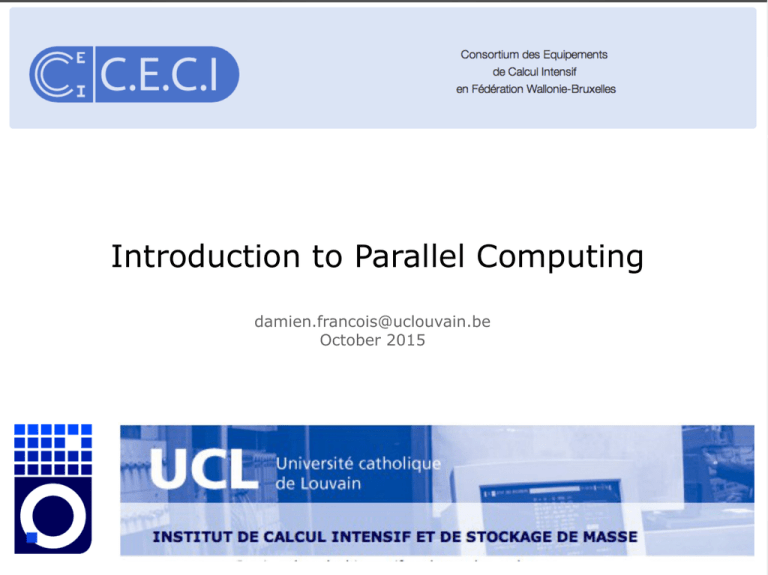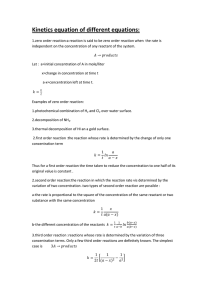slides
advertisement

Introduction to Parallel Computing
damien.francois@uclouvain.be
October 2015
1
Why parallel?
Speed up – Solve a problem faster
→ more processing power
(a.k.a. strong scaling)
Scale up – Solve a larger problem
→ more memory and network capacity
(a.k.a. weak scaling)
Scale out – Solve many problems
→ more storage capacity
2
Agenda
1. General concepts
2. Hardware
3. Programming models
4. User tools
3
1.
General concepts
4
Amdahl's Law
5
https://en.wikipedia.org/wiki/Amdahl%27s_law
Gustafson's law
“Scaling can be linear anyway providing
sufficiently enough data are used.”
6
https://en.wikipedia.org/wiki/Gustafson%27s_law
Parallel overhead
7
https://computing.llnl.gov/tutorials/parallel_comp/images/helloWorldParallelCallgraph.gif
How parallel?
●
●
Parallelization means
–
distributing work to processors
–
distributing data (if memory is distributed)
and
–
synchronization of the distributed work
–
communication of remote data to local processor (if
memory is distributed)
8
Decomposition
●
Work decomposition : task-level parallelism
●
Data decomposition : data-level parallelism
●
Domain decomposition : decomposition of work and data
is done in a higher model, e.g. in the reality
9
Collaboration
●
●
●
●
Synchronous (SIMD) at the processor level
Fine-grained parallelism if subtasks must communicate
many times per second (instruction level); loosely
synchronous
Coarse-grained parallelism if they do not communicate
many times per second (function-call level)
Embarrassingly parallel if they rarely or never have to
communicate (asynchronous)
10
Parallel programming paradigms
●
Task-farming (master/slave or work stealing)
●
Pipelining (A->B->C, one process per task concurrently)
●
SPMD (pre-defined number of processes created)
●
●
Divide and Conquer (processes spawned at need and
report their result to the parent)
Speculative parallelism (processes spawned and result
possibly discarded)
11
2.
Hardware
12
At the processor level
●
●
Instruction-level parallelism
(ILP)
–
Instruction pipelining
–
Superscalar execution
–
Out-of-order execution
–
Speculative execution
Single Instruction Multiple
Data (SIMD)
13
At the computer level
●
●
Multithreading
–
SMP
–
NUMA
Accelerators
14
At the system level
Distributed computing – Grids – Clusters – Cloud
15
Distributed computing
16
Cluster computing
17
Grid computing
18
Cloud computing
19
3.
Programming models
20
Programming models
●
CUDA, OpenCL
●
PThreads, OpenMP, TBB
●
MPI
●
CoArray, UPC
●
MapReduce
●
Boinc
21
CUDA, OpenCL (own session)
●
Shared memory
●
Single Machine / Multiple devices
●
Work decomposition
●
Single Program Multiple Data
●
Synchronous (SIMD)
22
CUDA (C/C++/Fortran)
23
http://computer-graphics.se/hello-world-for-cuda.html
OpenCL (C/C++)
24
http://www.fixstars.com/en/opencl/book/OpenCLProgrammingBook/first-opencl-program/
Pthreads, OpenMP (own session)
●
Shared memory
●
Single machine
●
Work decomposition
●
Single Program Multiple Data
●
Fine-grained/Coarse-grained parallelism
25
Pthreads
26
https://en.wikipedia.org/wiki/POSIX_Threads
OpenMP (C/Fortran)
27
https://en.wikipedia.org/wiki/OpenMP
Threading Building Blocks
●
Shared memory
●
Single machine
●
Data decomposition, Work decomposition
●
Single Program Multiple Data
●
Fine-grained parallelism
28
Threading Building Blocks (C++)
29
http://www.ibm.com/developerworks/aix/library/au-intelthreadbuilding/
Message Passing Interface
(own session)
●
Distributed memory
●
Multi-machine (Cluster computing)
●
Data decomposition, Work decomposition
●
Single Program Multiple Data
●
Coarse-grained parallelism
30
MPI (C/Fortran)
31
https://en.wikipedia.org/wiki/Message_Passing_Interface
Partitioned global address space
●
Shared memory
●
Multi-machine (Cluster computing)
●
Data decomposition, Work decomposition
●
Single Program Multiple Data
●
Coarse-grained parallelism
32
Co-Array Fortran
33
https://en.wikipedia.org/wiki/Coarray_Fortran
UPC (C)
34
http://www.upc.mtu.edu/tutorials/helloworld.html
MapReduce, Boinc
●
Distributed memory
●
Multi-machine (Distributed computing, Cloud computing)
●
Data decomposition
●
Divide and Conquer
●
Embarrassingly parallel
35
Map/Reduce (Java, Python, R, ...)
36
http://discoproject.org/
Boinc (C)
37
http://www.spy-hill.com/help/boinc/hello.html
4.
User tools
when you cannot modify the program
38
Parallel processes in Bash
39
Parallel processes in Bash
40
One program and many files
41
Several programs and one file
42
One program and one large file
Need recent version of Coreutils/8.22-goolf-1.4.10
43
Several programs and many files
44
Several programs and many files
45
Summary
●
You have either
–
one very large file to process
–
with one program (split – task farming)
● with several programs (pipes, fifo – pipeline)
many files to process
●
with one program (xargs – task farming)
● with many programs (make – divide and conquer)
Always embarrassingly parallel, work decomposition
●
●
46
GNU Parallel
●
Syntax: parallel command ::: argument list
47
GNU Parallel
●
Syntax: {} as argument placeholder. Can be modified
48
GNU Parallel
●
Syntax: --xapply
49
GNU Parallel
●
Syntax: :::: arguments in file
50
GNU Parallel
●
Syntax: --pipe
51
Other interesting options
-S
Use remote servers through SSH
-j n
Run n jobs in parallel
-k
Keep same order
--delay n Ensure there are n seconds between each start
--timeout n Kill task after n seconds if still running
Author asks to be cited: O. Tange (2011): GNU Parallel The Command-Line Power Tool, The USENIX Magazine,
February 2011:42-47.
52
Exercises
●
Can you reproduce the examples with ./lower and
./upper.sh using GNU Parallel?
53
Solutions
●
One program and many files
dfr@hmem00:~/parcomp $ time -k parallel ./lower.sh {} > res.txt ::: d?.txt
●
one program and one large file
dfr@hmem00:~/parcomp $ time cat d.txt | parallel -k -N1 --pipe ./lower.sh
{} > res.txt
●
several programs and several files
dfr@hmem00:~/parcomp $ time { parallel ./lower.sh {} {.}.tmp ::: d?.txt ;
parallel ./upper.sh {} {.}.res ::: d?.tmp ; }
54





